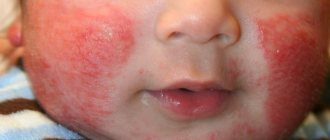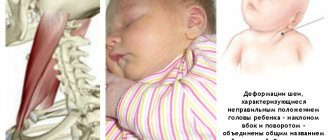4892Pavel
Any pet can cause allergies in a baby. A mother should know how a baby’s allergy to cats manifests itself in order to recognize these signs in time and provide help to the baby.
An allergic reaction is the body's response to an allergen. It occurs when saliva, fur, or cat scales come into contact with a child’s skin. It also happens that the cat itself is unable to cause such a reaction, but is a carrier of dust, pollen or other allergens.
Can it happen on hairless animals?
Allergies can occur to cats with or without fur.
As mentioned above, the main cause of allergies is not animal fur, but a protein that the cat secretes .
It can accumulate on the skin of hairless cats. If you pet this animal, the allergen will get on the child’s skin, which will cause an allergy.
Absolutely any breed of cat can cause this reaction. If a child is allergic to a cat, it should never be kept in the house, so as not to provoke an exacerbation of the disease.
Diagnostics
Diagnosis of allergies is easy if there is a cat in the house. If you move to another room where there has never been a cat, the symptoms will disappear. But if you relocate a cat, then no. After all, allergens tend to remain on curtains, carpets, upholstered furniture, bedspreads and other household items.
Diagnostic methods used to confirm the diagnosis:
- collection of urine and blood tests;
- examination, medical history of the mother;
- examination, taking the necessary scrapings;
- differential diagnosis.
© shutterstock
Cat breeds that do not cause allergies
If you have a baby in your home and you want to get a cat, but are afraid of the possible consequences for the child, then you should study information about which cats children are not allergic to. Despite the fact that many experts and breeders say that there are no cats that do not cause allergies, there is still a way out . After all, there are breeds whose number of allergens is very low and breeding them in an apartment is practically safe for a child.
Symptoms and signs
How does a cat allergy manifest in children? Certain symptoms help identify the disease :
- redness of the skin, mucous membranes;
- the child begins to sneeze if there is a cat in the room;
- If a baby pets a cat, his skin begins to itch and swell. Possible rash. The spots can be either small or large. As the disease progresses, they increase in size and become bright red;
- In a room with a cat, the child experiences severe shortness of breath and coughing;
- runny nose. There may be copious nasal discharge.
Associated signs of manifestation are : dizziness, fever, weakness, indigestion. The baby becomes whiny. The longer the contact with the cat, the stronger the allergy will manifest itself.
Photo:
Are children allergic to bananas? Find out the answer right now.
Prevention
If it is determined that the cause of the allergy is indeed a cat, the doctor will recommend excluding the pet from living in the same apartment with a child with allergies. If this cannot be done for some reason, measures should be taken to minimize exposure to the allergen. The same methods can be used for prevention purposes if there is a predisposition to allergies.
- First of all, if we are talking about a newborn baby, continue breastfeeding as long as possible. This will not only reduce the risk of allergies compared to artificial feeding, but will also increase the baby’s overall immunity.
- Reduce the amount of contact your child has with the cat. Make sure that he takes his pet in his arms less often, does not bring it to his face, etc.
- Wet clean your home daily, use air purifiers and ionizers.
- Don't let your cat sleep on your child's bed. Make sure there are no drafts in the apartment. Keep the nursery door tightly closed.
- If you have carpets at home, try to replace them with a hard surface - linoleum or laminate. Carpets, like rugs, accumulate a large number of different particles.
- Close all bookcases and clothing shelves tightly.
- Use pillows with artificial fillings.
What is accompanied by?
In a child, allergies are accompanied by sleep disturbances, appetite disturbances, and aggressiveness. The baby often cries and feels weak. With severe allergies, angioedema , anaphylactic shock, and nasal congestion may occur.
In case of anaphylactic shock, only an emergency doctor can help the baby, since pharmaceutical drugs are powerless and a therapeutic injection is needed.
You need to monitor the baby's condition very carefully. If your baby is choking or there is severe swelling, you need to call an ambulance.
If you are allergic to cats, a similar reaction may also occur to other animals: hamsters, dogs, rabbits. The protein secreted by the body is similar in these animals, and dust can accumulate in their fur, so that a child will develop an allergy quickly. The symptoms are identical.
Do all cats cause allergies?
All the rumors that hairless cats (Sphynx cats), as well as some short-haired breeds, do not cause an allergic reaction are misconceptions.
Yes, the risk of developing allergies with such animals is lower due to the lack of hair, but no one has canceled skin and genitourinary secretions, so the animal secretes quite a lot of protein in any case. Remember: cats that do not cause allergies in people do not exist.
Another thing is that some animals have significantly less impact on the human body than others.
- Males are lazier than females, they climb trees less and sleep more. Accordingly, their wool is cleaner. In addition, their hormonal secretions are not so active, people get a little protein. Conclusion: males are less dangerous than females.
- Those animals that walk a lot on the street, willy-nilly or not, encounter dust, pollen and other human allergens. If the cat stays at home more, then people have to deal with less irritants. Conclusion: pets that do not go outside are less allergenic.
- Kittens practically never go outside; their hormonal levels are not as strong and active as those of adult animals. Accordingly, young animals rarely cause allergies in humans.
It has been noticed that dark-colored cats are much more likely to cause allergic reactions than their light-colored relatives. Why is this happening? Science is not yet ready to answer this question, but there is an opinion that dark hair more actively attracts parasites.
Important! There are “owners” who shave their cats’ fur to prevent allergies. This will not help cope with the immune response, and the animal will suffer greatly. You shouldn't do that.
How to cure cat allergies
To find out how to get rid of a cat allergy, you should immediately consult a doctor. He will carry out the necessary procedures that will confirm or refute the diagnosis. The simplest and fastest way to check is an analysis in which blood is taken from a vein for laboratory testing. If the conclusion is positive and suspicions are confirmed, treatment is prescribed.
If the visit to the doctor was timely and manifestations of allergies are minimal, the doctor advises isolating the animal from the child. At the same time, you should not lock the cat in another room, because this can only help for a while. It should be given to friends or relatives to reduce the risk of possible contact and exacerbation of the disease. After a pet is forced to move, it is necessary to carry out a thorough general cleaning.
If for some reason the owners are not ready to part with their pet, then they should not allow the cat to sleep next to the child.
Diagnostic methods
If the first signs of an allergy appear, you should consult a doctor. Such violations are dealt with by an allergist, who prescribes tests to identify the allergen.
To do this, skin tests are taken and blood tests are done for specific immunoglobulin E. Some allergy centers can conduct a compatibility analysis with a specific cat, for which you just need to bring a little pet hair.
It is important not to confuse the type of allergy. There is a high probability that the signs of intolerance are caused not by the protein, but by dirt brought by the cat from the street, litter, dry food, or indicate some kind of disease (lichen, scabies mite).
Video from an expert:
Treatment
You can cure a child with medications and folk remedies .
They must be used in strictly recommended doses to avoid complications and overdose.
Drugs
Doctors prescribe medications for children with allergies to cats that relieve itching, redness of the skin, and swelling of the mucous membranes :
- Zyrtec;
- Zodak;
- Claritin.
The child should be given half a tablet of one of the medications twice a day.
Take the drug only for the first five days to avoid complications due to overdose.
To combat the rash, according to allergists, you need to use ointments:
- Bepanten;
- Advantan;
- La Cree.
The product is used morning and evening, applied in a thin layer to the skin , lightly massaging.
You will find pediatricians' recommendations for treating diaper allergies in babies on our website.
Folk remedies
- Motherwort helps to recover . To do this, pour a tablespoon of crushed plant into a glass of boiling water and leave for two hours. Next, the product is filtered. They gargle up to five times a day. This will help relieve swelling of the mucous membranes and eliminate coughing.
- Eliminates itching and redness of the skin with aloe . To do this, the aloe leaf is washed, cut lengthwise and applied to the painful area for ten minutes, then the aloe is removed and the skin is lightly wiped with a napkin. The procedure is performed twice a day.
- Dandelion herb is effective in combating allergies . The fresh plant is passed through a meat grinder and the juice is squeezed out. It needs to be diluted halfway with water. The resulting mixture is placed on low heat and brought to a boil. Then it must be removed from the heat and cooled. Take the medicine one teaspoon 2-3 times a day shortly before meals.
Causes
Allergies can be caused by:
- Cat fur. This reaction occurs during prolonged contact with representatives of long-haired breeds. The wool of Merino and Angora cats is the most allergenic. If your baby has this form of allergy, he can get himself a short-haired or hairless cat.
- Cat secretions. Often, parents decide that it is the animal’s fur that causes an allergic reaction in their child. However, they do not know that saliva, feces or urine from a cat can have just as much effect. In the case when the reaction occurs to excretory products, it is worth abandoning the representative of any breed of cat. Therefore, if you know that the baby feels unusual in the presence of a pet, you need to find out what exactly the child reacts to.
- Cat dandruff. The toddler can react acutely to the proteins it contains. With this type of allergy, it is almost impossible to prevent its development in the presence of a pet. Therefore, in this case, it is also not recommended to have a cat.
- In addition to actual contact with an animal, cases of external introduction of an allergen cannot be excluded. A pet returning from a walk brings substances on its paws that provoke the development of allergies.
- Hereditary predisposition.
- With a weakened immune system and a tendency to allergies, a child may react sharply to the presence of a cat, but with improved health, such a reaction goes away.
How do the symptoms appear?
The disease makes children capricious and lethargic. But such symptoms can be confused with a common cold. In addition to rapid fatigue, there are disorders that are worth paying attention to and visiting an allergist.
Signs of a cat allergy:
- in the presence of a pet, the child constantly sneezes, the nose is stuffy;
- breathing becomes difficult, hoarseness and dry cough appear;
- eyes become red and watery;
- the skin turns red, and after contact with an animal, children develop irritation on their skin (see photo).
Photos of skin manifestations in children:
Some children experience only nasal congestion, while others suffer from watery eyes, a dry cough, or all three symptoms at once. Often allergies are seasonal, worsening at certain times of the year, or combined with other types of intolerance. Traditionally, the company of cat intolerance is hay fever.
Interestingly, a reaction to a pet can appear, and after a few weeks disappear without a trace. Addiction occurs, the human body adapts to the proximity of the animal.











